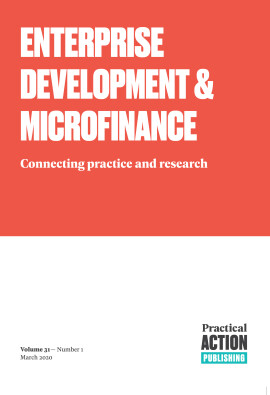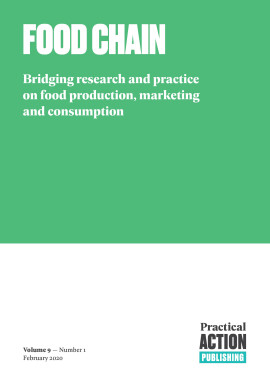Assessing the costs and consumer behaviour of increasing water connections in low-income areas of Maputo, Mozambique
Susie Kinghan | Richard Franceys | Carla Costa | Vannisaingam Baghirathan
Águas da Região de Maputo, the water utility serving the capital of Mozambique, has carried out water network expansion projects in peri-urban areas in partnership with the not-for-profit company Water and Sanitation for the Urban Poor. This research analyses data from 10 low-income neighbourhoods (bairros) which received network extensions between 2009 and 2014 enabling the propagation of individual domestic water connections. Data from the water utility and 900 household questionnaires undertaken in 2012 and 2017 is used to assess the financial costs and resulting customer behaviour of increasing coverage to the poor. The analysis shows a 78 per cent increase in customers in those neighbourhoods between 2010 and 2016, with the new customers paying a reduced connection fee of 2,000 MZN ($77). The cost of the distribution network extension to the utility is estimated as USD$48.50 per household (2017 prices). The resulting average monthly billed consumption was 9.29 m3 in 2016, corresponding to average monthly bills of 304 MZN ($4.85). The outcomes were positive and encouraging with 83 per cent of households reporting having a water connection, although 32 per cent of customers were consuming below the minimum monthly billed consumption of 5 m3. Bill collection efficiency increased from 50 per cent in 2009 to 80 per cent in 2016 in the newly served low-income areas.Cheng, D. (2013) ‘(In)visible urban water networks: the politics of non-payment in Manila’s low-income communities’, Environment and Urbanization 25(1): 249–60 <http://dx.doi.org/10.1177/0956247812469926>.
Cross, P. and Morel, A. (2005) ‘Pro-poor strategies for urban water supply and sanitation services delivery in Africa’, Water Science & Technology 51(8): 51–7.
Devoto, F., Duflo, E., Dupas, P., Parienté, W. and Pons, V. (2012) ‘Happiness on tap: piped water adoption in urban Morocco’, American Economic Journal: Economic Policy 4(4): 68–99 <http://dx.doi.org/10.1257/pol.4.4.68>.
Frauendorfer, R. and Liemberger, R. (2010) The Issues and Challenges of Reducing Non-Revenue Water [pdf], Philippines: Asian Development Bank <https://www.adb.org/sites/default/files/publication/27473/reducing-nonrevenue-water.pdf> [accessed 25 July 2018].
Heymans, C., Eales, K. and Franceys, R. (2014) The Limits and Possibilities of Prepaid Water in Urban Africa: Lessons from the Field [pdf], WSP Report, Washington, DC: World Bank Group <https://www.wsp.org/sites/wsp.org/files/publications/WSP-Prepaid-Water-Africa.pdf> [accessed 25 July 2018].
Instituto Nacional de Estatistica (INE) (2010) Projecções Anuais Da População Total, Urbana E Rural, Dos Distritos Da Cidade De Maputo 2007–2040, Maputo, Mozambique: INE.
Kayaga, S. and Franceys, R. (2007) ‘Costs of urban utility water connections: excessive burden to the poor’, Utilities Policy 15(4): 270–7 <http://dx.doi.org/10.1016/j.jup.2007.06.002>.
Kayaga, S., Franceys, R. and Sansom, K. (2004) ‘Bill payment behaviour in urban water services: empirical data from Uganda’, Journal of Water Supply: Research & Technology - Aqua 53(5): 339–49 <https://dspace.lboro.ac.uk/dspace-jspui/bitstream/2134/9700/8/Kayaga_Bill%20Payment%20behaviour.pdf> [accessed 25 July 2018].
Sohail, M., Bateman, J., Cotton, A. and Reed, B. (2006) ‘Pro-poor concessions for sustainable water services’, Proceedings of the Institute of Civil Engineering 160(CE2): 56–65 <http://dx.doi.org/10.1680/cien.2007.160.2.56>.
UN-Water (2017) UN-Water Global Analysis and Assessment of Sanitation and Drinking-Water (GLAAS) 2017 Report: Financing Universal Water, Sanitation and Hygiene under the Sustainable Development Goals, Geneva: World Health Organization <www.who.int/water_sanitation_health/publications/glaas-report-2017/en/> [accessed 25 July 2018].
World Bank Group and UNICEF (2017) Sanitation and Water for All: How Can the Financing Gap Be Filled? Discussion Paper, Washington, DC: World Bank <https://openknowledge.worldbank.org/handle/10986/26458> [accessed 25 July 2018].
World Health Organization (WHO) and the United Nations Children’s Fund (UNICEF) (2017) Progress on Drinking Water, Sanitation and Hygiene, 2017 Update [online], Geneva: World Health Organization <https://www.unicef.org/publications/index_96611.html> [accessed 31 July 2018].
Cheng, D. (2013) ‘(In)visible urban water networks: the politics of non-payment in Manila’s low-income communities’, Environment and Urbanization 25(1): 249–60 <http://dx.doi.org/10.1177/0956247812469926>.
Cross, P. and Morel, A. (2005) ‘Pro-poor strategies for urban water supply and sanitation services delivery in Africa’, Water Science & Technology 51(8): 51–7.
Devoto, F., Duflo, E., Dupas, P., Parienté, W. and Pons, V. (2012) ‘Happiness on tap: piped water adoption in urban Morocco’, American Economic Journal: Economic Policy 4(4): 68–99 <http://dx.doi.org/10.1257/pol.4.4.68>.
Frauendorfer, R. and Liemberger, R. (2010) The Issues and Challenges of Reducing Non-Revenue Water [pdf], Philippines: Asian Development Bank <https://www.adb.org/sites/default/files/publication/27473/reducing-nonrevenue-water.pdf> [accessed 25 July 2018].
Heymans, C., Eales, K. and Franceys, R. (2014) The Limits and Possibilities of Prepaid Water in Urban Africa: Lessons from the Field [pdf], WSP Report, Washington, DC: World Bank Group <https://www.wsp.org/sites/wsp.org/files/publications/WSP-Prepaid-Water-Africa.pdf> [accessed 25 July 2018].
Instituto Nacional de Estatistica (INE) (2010) Projecções Anuais Da População Total, Urbana E Rural, Dos Distritos Da Cidade De Maputo 2007–2040, Maputo, Mozambique: INE.
Kayaga, S. and Franceys, R. (2007) ‘Costs of urban utility water connections: excessive burden to the poor’, Utilities Policy 15(4): 270–7 <http://dx.doi.org/10.1016/j.jup.2007.06.002>.
Kayaga, S., Franceys, R. and Sansom, K. (2004) ‘Bill payment behaviour in urban water services: empirical data from Uganda’, Journal of Water Supply: Research & Technology - Aqua 53(5): 339–49 <https://dspace.lboro.ac.uk/dspace-jspui/bitstream/2134/9700/8/Kayaga_Bill%20Payment%20behaviour.pdf> [accessed 25 July 2018].
Sohail, M., Bateman, J., Cotton, A. and Reed, B. (2006) ‘Pro-poor concessions for sustainable water services’, Proceedings of the Institute of Civil Engineering 160(CE2): 56–65 <http://dx.doi.org/10.1680/cien.2007.160.2.56>.
UN-Water (2017) UN-Water Global Analysis and Assessment of Sanitation and Drinking-Water (GLAAS) 2017 Report: Financing Universal Water, Sanitation and Hygiene under the Sustainable Development Goals, Geneva: World Health Organization <www.who.int/water_sanitation_health/publications/glaas-report-2017/en/> [accessed 25 July 2018].
World Bank Group and UNICEF (2017) Sanitation and Water for All: How Can the Financing Gap Be Filled? Discussion Paper, Washington, DC: World Bank <https://openknowledge.worldbank.org/handle/10986/26458> [accessed 25 July 2018].
World Health Organization (WHO) and the United Nations Children’s Fund (UNICEF) (2017) Progress on Drinking Water, Sanitation and Hygiene, 2017 Update [online], Geneva: World Health Organization <https://www.unicef.org/publications/index_96611.html> [accessed 31 July 2018].
Cheng, D. (2013) ‘(In)visible urban water networks: the politics of non-payment in Manila’s low-income communities’, Environment and Urbanization 25(1): 249–60 <http://dx.doi.org/10.1177/0956247812469926>.
Cross, P. and Morel, A. (2005) ‘Pro-poor strategies for urban water supply and sanitation services delivery in Africa’, Water Science & Technology 51(8): 51–7.
Devoto, F., Duflo, E., Dupas, P., Parienté, W. and Pons, V. (2012) ‘Happiness on tap: piped water adoption in urban Morocco’, American Economic Journal: Economic Policy 4(4): 68–99 <http://dx.doi.org/10.1257/pol.4.4.68>.
Frauendorfer, R. and Liemberger, R. (2010) The Issues and Challenges of Reducing Non-Revenue Water [pdf], Philippines: Asian Development Bank <https://www.adb.org/sites/default/files/publication/27473/reducing-nonrevenue-water.pdf> [accessed 25 July 2018].
Heymans, C., Eales, K. and Franceys, R. (2014) The Limits and Possibilities of Prepaid Water in Urban Africa: Lessons from the Field [pdf], WSP Report, Washington, DC: World Bank Group <https://www.wsp.org/sites/wsp.org/files/publications/WSP-Prepaid-Water-Africa.pdf> [accessed 25 July 2018].
Instituto Nacional de Estatistica (INE) (2010) Projecções Anuais Da População Total, Urbana E Rural, Dos Distritos Da Cidade De Maputo 2007–2040, Maputo, Mozambique: INE.
Kayaga, S. and Franceys, R. (2007) ‘Costs of urban utility water connections: excessive burden to the poor’, Utilities Policy 15(4): 270–7 <http://dx.doi.org/10.1016/j.jup.2007.06.002>.
Kayaga, S., Franceys, R. and Sansom, K. (2004) ‘Bill payment behaviour in urban water services: empirical data from Uganda’, Journal of Water Supply: Research & Technology - Aqua 53(5): 339–49 <https://dspace.lboro.ac.uk/dspace-jspui/bitstream/2134/9700/8/Kayaga_Bill%20Payment%20behaviour.pdf> [accessed 25 July 2018].
Sohail, M., Bateman, J., Cotton, A. and Reed, B. (2006) ‘Pro-poor concessions for sustainable water services’, Proceedings of the Institute of Civil Engineering 160(CE2): 56–65 <http://dx.doi.org/10.1680/cien.2007.160.2.56>.
UN-Water (2017) UN-Water Global Analysis and Assessment of Sanitation and Drinking-Water (GLAAS) 2017 Report: Financing Universal Water, Sanitation and Hygiene under the Sustainable Development Goals, Geneva: World Health Organization <www.who.int/water_sanitation_health/publications/glaas-report-2017/en/> [accessed 25 July 2018].
World Bank Group and UNICEF (2017) Sanitation and Water for All: How Can the Financing Gap Be Filled? Discussion Paper, Washington, DC: World Bank <https://openknowledge.worldbank.org/handle/10986/26458> [accessed 25 July 2018].
World Health Organization (WHO) and the United Nations Children’s Fund (UNICEF) (2017) Progress on Drinking Water, Sanitation and Hygiene, 2017 Update [online], Geneva: World Health Organization <https://www.unicef.org/publications/index_96611.html> [accessed 31 July 2018].
Cheng, D. (2013) ‘(In)visible urban water networks: the politics of non-payment in Manila’s low-income communities’, Environment and Urbanization 25(1): 249–60 <http://dx.doi.org/10.1177/0956247812469926>.
Cross, P. and Morel, A. (2005) ‘Pro-poor strategies for urban water supply and sanitation services delivery in Africa’, Water Science & Technology 51(8): 51–7.
Devoto, F., Duflo, E., Dupas, P., Parienté, W. and Pons, V. (2012) ‘Happiness on tap: piped water adoption in urban Morocco’, American Economic Journal: Economic Policy 4(4): 68–99 <http://dx.doi.org/10.1257/pol.4.4.68>.
Frauendorfer, R. and Liemberger, R. (2010) The Issues and Challenges of Reducing Non-Revenue Water [pdf], Philippines: Asian Development Bank <https://www.adb.org/sites/default/files/publication/27473/reducing-nonrevenue-water.pdf> [accessed 25 July 2018].
Heymans, C., Eales, K. and Franceys, R. (2014) The Limits and Possibilities of Prepaid Water in Urban Africa: Lessons from the Field [pdf], WSP Report, Washington, DC: World Bank Group <https://www.wsp.org/sites/wsp.org/files/publications/WSP-Prepaid-Water-Africa.pdf> [accessed 25 July 2018].
Instituto Nacional de Estatistica (INE) (2010) Projecções Anuais Da População Total, Urbana E Rural, Dos Distritos Da Cidade De Maputo 2007–2040, Maputo, Mozambique: INE.
Kayaga, S. and Franceys, R. (2007) ‘Costs of urban utility water connections: excessive burden to the poor’, Utilities Policy 15(4): 270–7 <http://dx.doi.org/10.1016/j.jup.2007.06.002>.
Kayaga, S., Franceys, R. and Sansom, K. (2004) ‘Bill payment behaviour in urban water services: empirical data from Uganda’, Journal of Water Supply: Research & Technology - Aqua 53(5): 339–49 <https://dspace.lboro.ac.uk/dspace-jspui/bitstream/2134/9700/8/Kayaga_Bill%20Payment%20behaviour.pdf> [accessed 25 July 2018].
Sohail, M., Bateman, J., Cotton, A. and Reed, B. (2006) ‘Pro-poor concessions for sustainable water services’, Proceedings of the Institute of Civil Engineering 160(CE2): 56–65 <http://dx.doi.org/10.1680/cien.2007.160.2.56>.
UN-Water (2017) UN-Water Global Analysis and Assessment of Sanitation and Drinking-Water (GLAAS) 2017 Report: Financing Universal Water, Sanitation and Hygiene under the Sustainable Development Goals, Geneva: World Health Organization <www.who.int/water_sanitation_health/publications/glaas-report-2017/en/> [accessed 25 July 2018].
World Bank Group and UNICEF (2017) Sanitation and Water for All: How Can the Financing Gap Be Filled? Discussion Paper, Washington, DC: World Bank <https://openknowledge.worldbank.org/handle/10986/26458> [accessed 25 July 2018].
World Health Organization (WHO) and the United Nations Children’s Fund (UNICEF) (2017) Progress on Drinking Water, Sanitation and Hygiene, 2017 Update [online], Geneva: World Health Organization <https://www.unicef.org/publications/index_96611.html> [accessed 31 July 2018].
Improving access to urban piped drinking water services in Africa: a scoping review
Weston, Sally L.
Nijhawan, Anisha
Reddy, Olivia
Kulabako, Robinah
MacCarthy, Joseph M.
Kayaga, Sam
Howard, Guy
Water Supply, Vol. 24 (2024), Iss. 12 P.4059
https://doi.org/10.2166/ws.2024.251 [Citations: 2]- Providing municipal faecal sludge management services: lessons from Bangladesh
- Webwatch
- A call to action: organizational, professional, and personal change for gender transformative WASH programming
- Menstrual hygiene management: education and empowerment for girls?
- WASH challenges to girls’ menstrual hygiene management in Metro Manila, Masbate, and South Central Mindanao, Philippines


